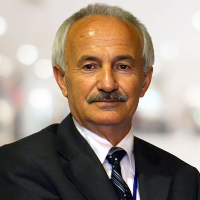ISCC 2025

Firat University, Turkey
Abstract:
Metals and alloy systems have different phases at the phase diagrams depending on the alloy compositions and exhibit different characteristics. Shape memory alloys take place at the β-phase region, with alloy composition. However, these alloys take place in class of smart and advanced structural materials, with the response to the variation of temperature and external conditions, by exhibiting a peculiar property called shape memory effect. This phenomenon is characterized by the recoverability of two certain shapes of material at different conditions. Shape memory effect is initiated with thermomechanical processes on cooling and deformation, and performed thermally on heating and cooling, with which shape of the materials cycle between original and deformed shapes in reversible way. Therefore, this behavior can be called Thermal Memory or Thermoelasticity. This deformation is plastic deformation, due to the soft character of the material in low temperature condition, deformation energy is stored in the material and released on heating by recovering the original shape. These alloys are used as shape memory devices in many fields such as medicine, metallurgy, building industry. This property is result of the crystallographic transformations, thermal and stress induced martensitic transformations. Thermal induced martensitic transformation occurs on cooling with cooperative movements of atoms by means of lattice invariant shears in -type directions on the {110} - type planes of parent phase, along with lattice twinning and ordered parent phase structures turn into the twinned martensite structures. Twinned structures turn into the detwinned structures by means of stress induced martensitic transformation, with deformation in the martensitic condition. Atomic movements are confined to the neighbor atom distances, and martensitic transformations are diffusionless or displacive transformations. Lattice invariant shears occur as martensite variants on {110} -type planes of austenite matrix which is basal plane of martensite. These shears occur, in -type directions on the {110}-type planes of the parent phase. The {110}- plane family represent 6 certain planes, , , , , , , and totally 24 martensite variants occur. These alloys exhibit another property called superelasticity, which is performed with stressing and releasing material in elasticity limit at a constant temperature in parent phase region, and shape recovery is performed simultaneously upon releasing the, by recovering the original shape. Parent phase of these alloys are hard phase, stressing and releasing steps exhibit elastic material behavior. Superelasticity is performed in non-linear way; stressing and releasing paths are different in the stress-strain diagram, and hysteresis loop refers to energy dissipation. Superelasticity is also result of stress induced martensitic transformation and ordered parent phase structures turn into detwinned martensite structure with stressing. However, lattice twining and detwinning reactions play important role in martensitic transformations.Copper- based alloys exhibit this property in metastable β-phase region. Lattice invariant shear and twinning is not uniform in these alloys and gives rise to the formation of complex layered structures. These structures can be described by different unit cells as 3R, 9R or 18R depending on the stacking sequences on the close-packed planes of the ordered lattice. The unit cell and periodicity are completed through 18 layers in direction z, in case of 18R martensite, and unit cells are not periodic in short range in direction z. In the present contribution, x-ray diffraction and transmission electron microscopy (TEM) studies were carried out on two copper- based CuAlMn and CuZnAl alloys. X-ray diffraction profiles and electron diffraction patterns exhibit super lattice reflections. X-ray diffractograms taken in a long-time interval show that diffraction angles and intensities of diffraction peaks change with the aging duration at room temperature. This result refers to the rearrangement of atoms in diffusive manner.
Biography:
Adiguzel graduated from
Department of Physics, Ankara University, Turkey in 1974 and received PhD-
degree from Dicle University, Diyarbakir-Turkey. He has studied at Surrey
University, Guildford, UK, as a post-doctoral research scientist in 1986-1987,
and studied were focused on shape memory effect in shape memory alloys. He
worked as research assistant, 1975-80, at Dicle University and shifted to Firat
University, Elazig, Turkey in 1980. He became professor in 1996, and he has
been retired on November 28, 2019, due to the age limit of 67, following
academic life of 45 years. He supervised 5 PhD- theses and 3 M. Sc- theses and
published over 80 papers in international and national journals; He joined over
120 conferences and symposia in international and national level as
participant, invited speaker or keynote speaker with contributions of oral or
poster. He served the program chair or conference chair/co-chair in some of
these activities. In particular, he joined in last six years (2014 - 2019) over
60 conferences as Keynote Speaker and Conference Co-Chair organized by
different companies. Also, he joined over 120 online conferences in the same
way in pandemic period of 2020-2022. Dr. Adiguzel served his directorate of
Graduate School of Natural and Applied Sciences, Firat University, in
1999-2004. He received a certificate awarded to him and his experimental group
in recognition of significant contribution of 2 patterns to the Powder
Diffraction File – Release 2000. The ICDD (International Centre for Diffraction
Data) also appreciates cooperation of his group and interest in Powder
Diffraction File
